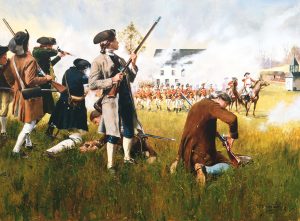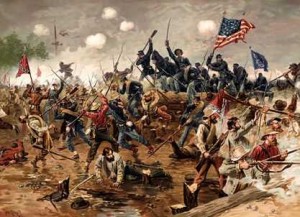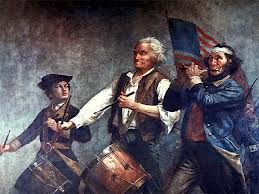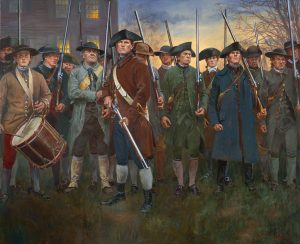Thanks go to RHT for this find…
CAPTAIN SAMUEL WHITTEMORE
Samuel Whittemore was born in England on July 27th, 1695, and came to North America as a Captain in His Majesty’s Dragoons, fighting the French in 1745. He was involved in the capture of the French stronghold, Fort Louisburg, and there captured a decorative french officer’s sword, which he cherished for the rest of his life. About its capture, all Sam would say is that its previous owner had “died suddenly”.
After the war he stayed in the colonies, purchasing a farm in Menotomy (now Arlington, Massachusetts). He married Elizabeth Spring, and after her death remarried to Mrs. Esther Prentice. By his two wives he had three sons and five daughters. His house, on Massachusetts Avenue, in Arlington, still exists. (7)
In 1758, war again broke out between England and France. And again, Fort Louisburg had to be taken. At 64 years of age, Sam volunteered and joined a Colonial Regiment which reduced the fort to rubble. He then went on and joined General James Wolf in the successful assault on Quebec.
The 1763 Indian Wars in the west next attracted Sam’s attention. Leaving his wife, children and grandchildren to attend the farm, he rode off to join the colonial force launched against the Ottawa chief, Pontiac. He returned home some months later with a brace of dueling pistols as a souvenir, and here again, all Sam would say is that the previous owner “died suddenly.”
It is recorded that Sam believed in American independence stating that he wanted his descendants to be able to enact their own laws and not be subject to a distant king. So, it is not surprising when he again took up arms on April 19th, 1775.
That night he watched as Colonel Smith led his column of 700 soldiers through Menotomy. He was probably concerned, but the British had come out of Boston before and there had not been any serious trouble. Later that morning he heard rumors that there had been fighting at Lexington and Concord. But, when General Percy marched through the town with an additional 1,400 soldiers, Sam’s military experience told him there was serious trouble – – ‘why else would the British be sending reinforcements?’ , he probably asked himself.
 Word had come to Menotomy that the combined, heavily engaged, columns of Smith and Percy were retreating toward the town, and were burning homes along the way, so the aged warrior decided to take action in spite of his being eighty years old! He strapped on his captured french sword, stuck his brace of dueling pistols in his belt, put on his powder horn and shot bag, took his musket from its place on his fireplace mantle and went to war!
Word had come to Menotomy that the combined, heavily engaged, columns of Smith and Percy were retreating toward the town, and were burning homes along the way, so the aged warrior decided to take action in spite of his being eighty years old! He strapped on his captured french sword, stuck his brace of dueling pistols in his belt, put on his powder horn and shot bag, took his musket from its place on his fireplace mantle and went to war!
Sam selected a position that gave him a excellent view of the road from Lexington, and sat down to wait. His fellow minuteman from Menotomy pleaded for him to find a safer position, but he choose to ignore them.
His fellow minuteman started firing at the oncoming British Grenadiers of the 47th Regiment of Foot, falling back to reload, then firing again. Sam waited. Finally, when the column was directly in front of him, he stood and fired his musket. A grenadier fell dead. He drew his two pistols, firing both at almost point blank range. Another grenadier fell dead, a third fell mortally wounded. The British soldiers were on top of him, he had not the time to reload his musket or pistols, so drawing his sword, he . started flailing away at the bayonet wielding soldiers. A soldier leveled his Brown Bess musket, at point blank range and fired. The .69 calibre ball struck Sam in the cheek, tearing away part of his face and throwing him to the ground. Sam valiantly tried to rise, fending off bayonet thrusts with his sword, but he was overpowered. Struck in the head with a musket butt, he went down again, then was bayoneted thirteen times and left for dead.
the time to reload his musket or pistols, so drawing his sword, he . started flailing away at the bayonet wielding soldiers. A soldier leveled his Brown Bess musket, at point blank range and fired. The .69 calibre ball struck Sam in the cheek, tearing away part of his face and throwing him to the ground. Sam valiantly tried to rise, fending off bayonet thrusts with his sword, but he was overpowered. Struck in the head with a musket butt, he went down again, then was bayoneted thirteen times and left for dead.
The British continued their fight through the streets of Menotomy, which turned out to be the costliest action of the day. They left forty of their soldiers dead in the town and another eighty wounded, half the casualties of the day.
After the British column had fought its way clear, the town’s people and minuteman started to search for their wounded compatriots. Several had seen Sam Whittemore’s “last stand” and approached to remove his body. To everyone’s astonishment Sam was not only still alive, but conscious and still full of fight. Laying there, he was trying to load his musket!
Using a door as a makeshift stretcher, Sam was carried to Cooper Tavern, which was being used as a emergency hospital. Doctor Nathaniel Tufts of Medford attended to Sam. He cut off his bloody clothes, and exposed the gaping bayonet wounds. Sam’s face was horribly injured. Doctor Tufts knew the injuries were fatal, stating it wouldn’t do any good to even dress the wounds. Sam’s family and friends insisted and Dr. Tufts did the best he could. He tried to make the old man as comfortable as possible. After his wounds were attended to Sam was carried to his home, to die surrounded by his family. To everyone’s utter amazement Captain Sam Whittemore lived! He recovered and remained active for the next eighteen years. He was terribly scarred, but always was proud of what he had done for his adopted country. He is quoted as having stated that he would take the same chances again.
You can question the old soldier’s tactical judgment, making the stand in the manner he did, but you can never question his bravery. He also proved you are never too old! Sam died on February 3rd, 1793, age 98 and is buried in the town’s cemetery.
General Hugh Percy shared the opinion that the colonists would never fight, or if they did, they would be ineffective. After his fighting retreat, he wrote to General Harvey, in England: “… during the whole affair the Rebels attacked is in a very scattered, irregular manner, but with perseverance and resolution, nor did they ever dare to form into any regular body. Indeed, they knew too well what was proper, to do so.
Whoever looks upon them as an irregular mob, will find himself much mistaken. They have men amongst them who know very well what they are about, having been employed as Rangers against the Indians and Canadians and this country being much covered with wood, and hilly, is very advantageous for their method of fighting. . . . “.
Link—
http://www.revolutionarywararchives.org/whittemore.htmlhttp://www.revolutionarywararchives.org/whittemore.html
___________________________________________
April 19, 1775
The Revolutionary War begins with shots fired at Lexington and Concord in Massachusetts.
June 7, 1776
Richard Henry Lee introduces a motion in a meeting of the Continental Congress that the United States is and should be declared free from ties to Great Britain. Delegates disagree about the wisdom of this idea, which comes to be called the “Lee Resolution.” Eventually, the Congress appoints a Committee of Five to draft a Declaration of Independence for consideration.
June 11, 1776
John Adams convenes the Committee of Five to draft a Declaration of Independence. The five members of the committee are John Adams, Benjamin Franklin, Thomas Jefferson, Robert Livingston and Roger Sherman. The committee chooses Jefferson to write the first draft.
Two days in mid-June, 1776
Jefferson writes the first draft of the Declaration. He said later that he never meant to say things that “had never been said before.” Instead, he tries to capture “the common sense of the subject, in terms so plain and firm as to command their assent.”
July 2, 1776
The Continental Congress votes to declare independence from Great Britain, formally adopting the Lee Resolution. The next day John Adams writes in a letter to his wife that, “The second day of July, 1776, will be the most memorable epocha in the history of America. . . . It ought to be solemnized with pomp and parade, with shows, games, sports, guns, bells, bonfires, and illuminations, from one end of this continent to the other, from this time forward, forevermore.”
July 3, 1776
The Continental Congress begins debating and editing the draft Declaration, eventually making 86 edits and cutting the length by about a fourth.
July 4, 1776
The Continental Congress approves the final draft of the Declaration, formalizing what had already been decided on July 2. Congress hires printer John Dunlap to print copies of the Declaration to be distributed throughout the colonies.
July 5, 1776
Dunlap delivers his 200 copies of the Declaration (which are now called “Dunlap Broadsides”). One copy is officially entered into the Congressional Journal and the other copies are distributed throughout the colonies.
July 6, 1776
The Pennsylvania Evening Post becomes the first newspaper to reprint the whole Declaration, but news of the July 2 decision to declare independence has already been widely reported and various celebrations and discussions are already taking place throughout the colonies.
July 8, 1776
The Declaration is read publicly to the people of Philadelphia. Around this time, Congress gets around to sending a copy of the Declaration to its emissary in Europe to be distributed to the various European governments. However, the original letter is lost and the Declaration isn’t formally delivered to Great Britain and the rest of Europe until November, when news of the Declaration had already reached Europe.
July 9, 1776
New York finally approves the Declaration. It is the last of the 13 colonies to do so.
July 19, 1776
The Continental Congress decides to have an “engrossed” copy of the Declaration made, meaning a clean, readable, handwritten copy on parchment. Timothy Matlack, who was the assistant to the Secretary of Congress, probably makes the copy. (This is the copy now housed at the National Archives.)
August 2, 1776
Those delegates who had voted in favor of independence and who are in attendance that day sign the engrossed copy of the Declaration. Fifty delegates sign on this day. Six more will sign later.
From comments here—
https://borepatch.blogspot.com/2016/07/hollering-down-well.htmlhttps://borepatch.blogspot.com/2016/07/hollering-down-well.html

I just spend a very pleasant time reading the story of this patriot hero. Thank you all.